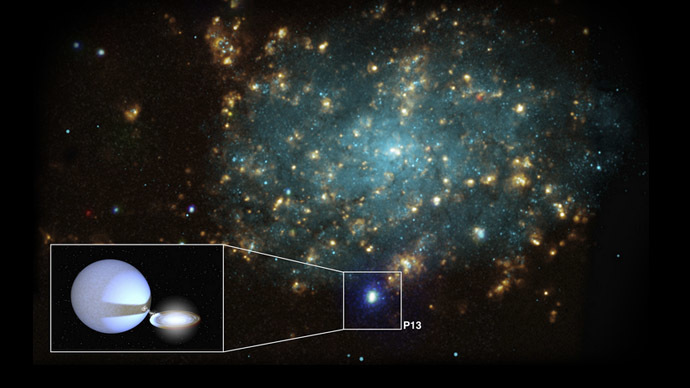We reach more than 65,000 registered users in Dec!! Register Now

The super hungry black hole eating its surroundings ten times faster than expected
- October 12, 2014
- 784 Views
- 0 Likes
- 0 Comment
Astronomers say they have found a black hole consuming a nearby star 10 times faster than previously thought possible. It's swallowing a weight equivalent to 100 billion billion hot dogs a minute, they claim. A black hole is an object so compact that its gravity is overwhelming, and pulls in anything that ...
Astronomers say they have found a black hole consuming a nearby star 10 times faster than previously thought possible.
It's swallowing a weight equivalent to 100 billion billion hot dogs a minute, they claim.
A black hole is an object so compact that its gravity is overwhelming, and pulls in anything that gets too near, including light. Although that accounts for the name ‚Äúblack,‚ÄĚ gases that are falling into a black hole can become very hot and bright, clearly illuminating their location.
Scientists first noticed the black hole, called P13, because it was a lot brighter than other black holes, said astronomer Roberto Soria of Curtin University in Australia, one of the researchers. But astronomers first assumed the object was just extremely big, because it was thought that size determines the maximum rate of a black hole's feeding.
‚ÄúIt made sense to assume that P13 was bigger than the ordinary,‚ÄĚ said Soria, who is also part of the International Centre for Radio Astronomy Research. But then, Soria and colleagues measured its mass, or weight, and found it was actually on the small side, despite being at least a million times brighter than the Sun.
It was only then that they realized just how much material it was consuming, he explained. The finding is published Oct. 8 in the journal Nature.
‚ÄúThere's not really a strict limit like we thought, black holes can actually consume more gas and produce more light,‚ÄĚ Soria said.
The black hole lies on the outskirts of the galaxy NGC7793, about 12 million light years from Earth. A light year is the distance light travels in a year.
P13 is sucking up gas from a donor star, Soria explained. Scientists noticed that one side of that star was always brighter than the other because it was lit up by X-rays coming from near the black hole. So the star looked brighter or fainter as it circled P13.
‚ÄúThis allowed us to measure the time it takes for the black hole and the donor star to rotate around each other, which is 64 days,‚ÄĚ he added. From that, they worked out that the black hole must ‚Äúweigh‚ÄĚ the equivalent of less than 15 of our Suns.
Soria compared P13 to small Japanese eating champion Takeru Kobayashi. ‚ÄúAs hotdog-eating legend Takeru Kobayashi famously showed us, size does not always matter in the world of competitive eating and even small black holes can sometimes eat gas at an exceptional rate,‚ÄĚ he said.
P13 is a member of a special group of black holes known as ultraluminous X-ray sources, he added. ‚ÄúThese are the champions of competitive gas eating in the Universe, capable of swallowing their donor star in less than a million years, which is a very short time on cosmic scales,‚ÄĚ he said.
Source : world-science.net









